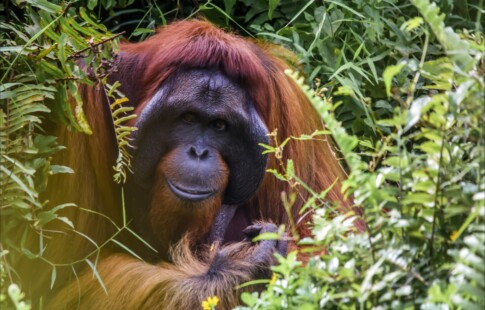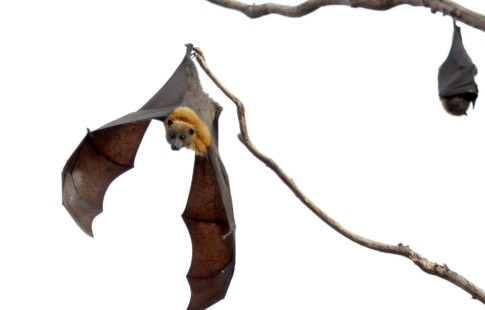
Why Are Red Pandas Endangered?
We are reader-supported. When you buy through links on our site, we may earn affiliate commission.
Small, shy, and elusive, red pandas captivate the human imagination and embody the definition of a charismatic species. They’re a rising star in pop culture, featured in everything from movies to TV shows and plush toys. YouTube abounds with videos of red pandas’ cute antics. If people love them so much, then why are red pandas endangered?
Species Profile
Red pandas occupy high-altitude, temperate forests in the Himalayas and nearby mountain ranges in Nepal, Bhutan, India, China, Tibet and Myanmar. They prefer areas with thick bamboo undergrowth because it comprises 98% of their diet, comparable to the eating habits of giant pandas. They also occasionally sample fruit, eggs, lizards and insects.
Although they bear the same name, red pandas and giant pandas aren’t closely related — linguists believe the word “panda” comes from the Nepali word for “bamboo eater,” which is the main trait the two species share. Their other name, “firefox,” doesn’t reflect their lineage, either. Red pandas are most closely related to skunks and raccoons.
The red panda population has become around 40% smaller in the past 20 years alone, and it’s still decreasing. Today, the figure is estimated to be around 10,000 individuals, with the highest concentrations in China. Consequently, red pandas have been listed as Endangered on the IUCN Red List since 2008.
Why Red Pandas Are Endangered
There are several factors contributing to the species’ rapid decline, including:
1. Habitat Loss and Fragmentation
Habitat loss is one of the biggest reasons why the red panda is considered endangered. Because the animals have such specific habitat requirements, any disturbance to the ecosystem can dramatically shrink their range. In many cases, red panda populations end up isolated from each other, confined to mountaintops. In Nepal, 70% of the red panda population is already split into 400 small forest patches. The following lead to habitat loss and fragmentation:
- Clearcutting: Removing all the trees or bamboo in an area means red pandas must leave to find food and shelter. Bamboo doesn’t easily reestablish in disturbed areas or after being clearcut.
- Logging operations: In addition to removing trees, logging operations are also extremely loud, which scares wildlife away.
- Gathering firewood and plants: Many people rely on firewood in the red panda’s range. Additionally, people often gather plants from the forest for use in traditional medicine. These activities degrade red panda habitat and scare the animals away.
- Crop and livestock production: Farmers clear fields to make room for crops and animals. Livestock often trample the vegetation as well.
- Urban development: Roads, electric transmission lines, and hydroelectric power plants can divide up a red panda’s habitat.
- Mining: Destructive mining practices destroy vegetation, are loud, and introduce more vehicular traffic in an area.
To make matters worse, a significant portion of red panda habitat is located outside designated conservation zones. The animal is documented to be observed in 24 districts, but only seven of these are protected areas.
2. Poaching
Interestingly, there doesn’t appear to be a large market for red panda parts. A few isolated incidents have found people wearing their furs or skins, but there isn’t a strong demand for them in traditional medicine like there is for many other species.
Still, poachers are desperate to feed themselves and their families, and will often kill red pandas based solely on rumors that they fetch a high black market price.
3. Climate Change
Red panda habitat falls within a very narrow temperature range. Their ideal climate is from 63 to 77 degrees Fahrenheit, but they have adapted responsive behaviors when temperatures exceed. In the winter, they curl into an adorable ball of fur to conserve body heat. They do the opposite in the summer, sprawling their limbs on tree branches to cool down.
However, as the world heats up, these behaviors aren’t enough to keep pace. The pandas are forced to move to higher elevations. This can isolate their populations from each other. Additionally, changing rainfall patterns have increased the risk of forest fires in red panda habitat. Droughts, snowfalls, and floods have also increased in the Himalayas, causing shifts in vegetation patterns.
4. Accidental Trapping
Red pandas often get caught in traps meant for bears and wolves. The large traps usually critically injure the pandas in the process, so very few survive the ordeal.
Unlike hunting with a gun, in which hunters can single out specific animals, traps are indiscriminate. This is part of what makes them so ecologically destructive. They activate when anything steps on them, whether it’s an endangered animal, pet, or even person.
Trapping is an inhumane hunting method that inflicts unnecessary pain and suffering. Animals caught in traps may survive for days before dying of dehydration, exposure, blood loss, predator attacks, or internal injuries.
5. The Illegal Pet Trade
It’s easy to understand why people want to keep red pandas as pets — they’re small, cute, and fluffy, like a cross between a cat and a teddy bear. However, the truth is that they make terrible pets.
Their long, sharp claws, perfectly suited for tree climbing, can easily inflict injuries on a person. They have a highly specialized diet that most people can’t replicate. Red pandas are solitary in nature, and they exude a strong, musky odor that most people wouldn’t want in the house.
Importantly, every red panda kept in captivity is one fewer in the wild. Even breeding red pandas in captivity does nothing to help the wild population unless they’re released, which most pet breeders never do.
6. Free-Roaming Dogs and Disease
Unrestrained dogs kill red pandas, either by directly attacking them or by spreading disease. Herders usually have livestock guardian dogs to protect their animals. Unfortunately, these dogs are often the ones that kill the pandas. Feral, hunting, and herding dogs also target them.
Dogs scare most wildlife away. Wild animals become less active in the daytime to avoid interacting with loose dogs, whose very smell is often enough to spook them. This is why many national parks ban dogs on trails.
Their feces often pollute water sources, and they can transmit seven types of gastrointestinal parasites to other species. Dogs also transmit rabies and canine distemper, the latter of which is always fatal for red pandas.
What’s Being Done to Save Red Pandas?
Conservation efforts target various aspects affecting the animal’s population decline. Since forests are the lifelines of these animals, organizations focus heavily on habitat restoration to help them thrive in the wild. Among these is the Red Panda Network, established in 2007, which works in 13 out of 23 red panda range districts in Nepal. They have since reseeded 96,424 native trees across more than 230 acres of deforested habitat.
Community-based conservation is also critical, as it gives locals a sense of ownership in monitoring and protecting red pandas. The first of such conservation zones was created in Puwamajhuwa, which spanned 287 acres of broadleaf forest.
Forest Guardians, trained stewards from local communities, monitor red panda populations four times a year in sync with the animals’ life cycle. Each of the 128 guardians carries GPS trackers, mobile phones, notebooks, measuring tapes, and scales to record signs of panda activity. They look for scat, claw marks, and other indicators of presence. The footage and patrol logs they generate guide conservation strategies and policies around protecting red pandas..
The Red Panda Network has also set a “Zero Poaching Goal” to combat the illegal trade in panda pelts. Their work includes raising awareness in local communities, dispelling myths about black market prices, and preventing residents from being drawn into organized wildlife crime networks.
To provide alternatives to poaching, associations promote income-generating activities such as producing and selling yak dung briquettes, an eco-friendly fuel source for herders. This reduces dependence on harvesting firewood from fragile red panda habitats while creating new livelihoods. Eco-tourism is another sustainable option for them to attract income. Guided treks, homestays, and locally sourced meals give travelers an authentic experience of Nepal, while a portion of the fees supports both conservation efforts and community well-being.
How to Help Red Pandas
Whether you live near the Himalayas or on the other side of the world, you can still help red pandas recover. Here’s how:
1. Donate to Conservation and Humanitarian Groups
Raise money for wildlife groups specializing in red panda conservation. This includes groups that help break the poverty cycle in countries where red pandas live.
Addressing poverty is the first step toward stopping the illegal wildlife trade. Poachers aren’t inherently evil or hunting for fun — most are simply trying to provide for their families under dire circumstances, whether by eating bushmeat or selling animal parts on the black market. When given alternative forms of livelihood, most poachers stop killing animals.
2. Don’t Support the Illegal Pet Trade
Exotic pets may be unique, but they’re exceedingly difficult to care for in a domestic setting. It’s also impossible to know where they originated. A poacher may have smuggled them from the wild, and many more could have died during transportation.
Are dogs and cats overrated? Don’t worry — you still have options. Why not adopt a ferret, which is closely related to red pandas and just as mischievous and cute?
3. Keep Carnivores Contained
To protect both wildlife and your pets, dogs should live in fenced areas, and cats should stay indoors or in a contained patio. Vaccinate your pets so they don’t spread diseases to wildlife. Be sure to spay or neuter them to avoid overpopulation.
4. Buy Ethical Fur
If you want to wear fur, make sure it comes either from an animal that was invasive, died of natural causes, or was hunted sustainably by someone with a permit. In many areas, for example, hunting is an important conservation measure to reduce deer populations, since people have extirpated their natural predators. Using every part of a sustainably hunted animal does not harm the environment.
However, avoid buying fur from factory-farmed animals raised in poor conditions. Additionally, never buy exotic or endangered animal fur, even if the person selling it claims to have simply found it. Regardless of whether they’re being truthful, it still creates a market for endangered animal products.
5. Spread the Word
Many people are unaware that red pandas are endangered or don’t even know they exist. You can spread awareness about their plight by talking about red pandas on social media. If you have children, take them to a wildlife sanctuary that houses red pandas and have a discussion about conservation.
FAQs
What’s the relationship between red pandas and bamboo forests?
Red pandas primarily eat bamboo leaves and shoots. However, they are extremely picky eaters, plucking only the most tender and nutritious leaf tips. They have grown adaptations like a false thumb or an extended wrist bone to grip bamboo stalks better. Aside from a source of diet, pandas also use dense bamboo thickets for shelter and nesting. Because of these, bamboo forests are critical to their preservation, and this habitat determines their survival.
How does climate change impact red panda habitats specifically?
Climate change is pushing bamboo growth zones to higher altitudes in a phenomenon called upslope shift. This leaves pandas with less space to live and feed, and if they follow where the bamboo goes, their populations become fragmented. In the Himalayas, unpredictable rainfall patterns and seasonal changes disrupt the growth of their staple food. Warmer and drier conditions also increase the risk of fires in their habitat.
Supporting Conservation
Why are red pandas endangered? There are numerous factors at play, including illegal poaching, accidental trapping, habitat destruction, and climate change. Their numbers may be dropping rapidly, but public awareness about red pandas is steadily rising. There’s still hope for these charming, elusive animals.
Thanks for being an Environment.co reader! Please enjoy a free red panda coloring page that you can print out at home.

This article was originally published on April 25, 2023 and was updated September 8, 2025 to provide readers with more updated information.
Share on
Like what you read? Join other Environment.co readers!
Get the latest updates on our planet by subscribing to the Environment.co newsletter!
About the author

Steve Russell
Steve is the Managing Editor of Environment.co and regularly contributes articles related to wildlife, biodiversity, and recycling. His passions include wildlife photography and bird watching.





